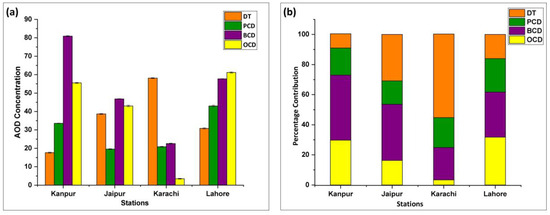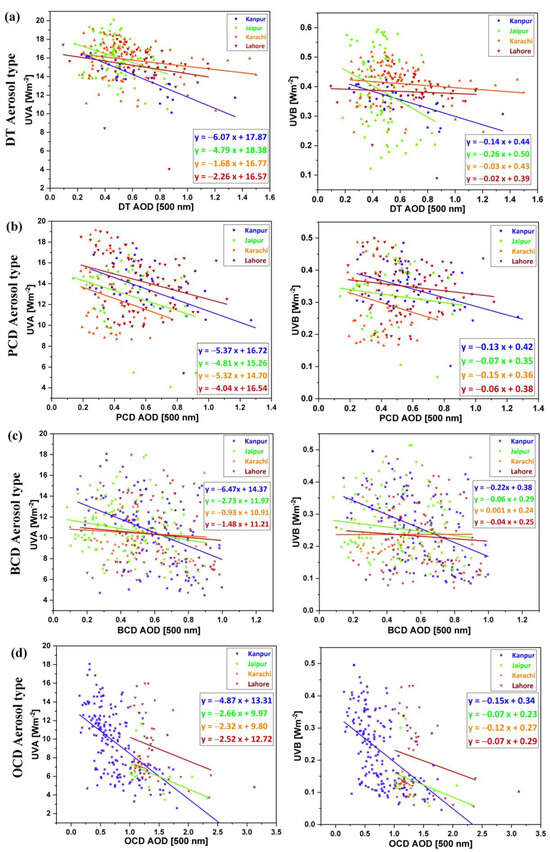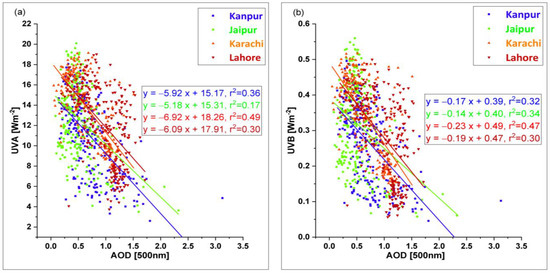Abstract
Atmospheric aerosols play a crucial role in the scattering and absorption of solar radiation, directly influencing the UV flux reaching the Earth’s surface. This study investigates the impact of different atmospheric aerosol types on the ultraviolet (UV) flux at four stations over the Indo-Gangetic plain (IGP). For this study, high-resolution 1° × 1° UVA and UVB data were obtained from Clouds and the Earth’s Radiant Energy System (CERES). Various aerosol types present in the atmosphere were categorized based upon their optical properties and their quantitative influence on UVA and UVB flux was examined. Ground-level aerosol products were obtained from the NASA-based Aerosol Robotic Network (AERONET) at four stations in the IGP. Based on the optical properties of aerosols (fine mode fraction, single scattering albedo, aerosol optical depth and angstrom exponent), four distinct atmospheric aerosol types were inferred, namely dust-dominant (DT), polluted-continental-dominant (PCD), black-carbon-dominant (BCD), and organic-carbon-dominant (OCD). It is observed that the AOD of different aerosol types when separated do not seem to have made significant effects on UVA/B radiation (except at Kanpur), possibly due to the statistically smaller data set. For the entire combined AOD, the effects on UVA/B became quite significant at all the stations, which shows that a unit rise in AOD leads to a reduction of 5–7 Wm−2 in UVA and 0.14–0.23 Wm−2 in UVB.
1. Introduction
The aerosol radiation interaction has become an emerging and challenging concept in the present scenario. As atmospheric aerosols act like attenuators for the incoming radiation, this significantly affects the radiation budget. These aerosols play a vital role in global and climatic changes through various atmospheric interactions in accordance to their optical, micro-physical and radiative properties [1,2]. Aerosols are of various types due to their origins and chemical compositions, and accordingly their classification encompasses diverse methodologies. In the context of overseeing air quality, aerosols are commonly categorized into four main types: dust-dominant (DT) (including desert dust, soils, volcanic ash, etc.), polluted-continental-dominant (PCD) (originating from urban/industrial activities or human-involved biomass burning), black-carbon-dominant (BCD) (high absorbing aerosols like incomplete combustion of carbon materials, etc.) and organic-carbon-dominant (OCD) (includes low absorbing aerosols and nitrates) [3,4]. The ultraviolet radiation (UVR) part of the solar spectrum is broadly classified into UVA (0.40–0.32 μm) and UVB (0.32–0.28 μm) radiations, which are highly influenced by these distinct aerosol types present in the atmosphere in various forms.
The Indo-Gangetic Plain (IGP) covers most of northern India and the eastern part of Pakistan, and includes large-scale agricultural activities and enormous demographic challenges. Increasing industrialization has led to an increase in anthropogenic activities, leading to consistent increases in aerosol over the region (it became the global hub for intense aerosol loading) [5,6]. Many studies have shown an implication of different aerosol particles over the region, but the interaction and effects of the pertaining aerosol types on UVA and UVB radiation have still been lacking in the long term [7,8,9,10]. The present study on the effect of distinct aerosol types on UVA and UVB at different stations of IGP tries to fill the existing gap to some extent.
As aerosols modulate UV radiation, this present study investigates the effects of various aerosol types on UVA and UVB radiation across different locations within the Indo-Gangetic Plain (IGP) region. The four sites of the IGP region are Kanpur, Jaipur, Karachi and Lahore, and the duration of study is one year (January 2021 to December 2021). We identified the annual concentration and percentage contribution of each type of aerosol. The effects of each aerosol type have been studied on the UVA and UVB radiation at the four different sites of the IGP considered for study.
2. Methodology
2.1. Observational Sites and Data Collection
The study has been conducted over the four different locations in the Indo-Gangetic plain (IGP), which are (a) Kanpur, (b) Jaipur, (c) Karachi and (d) Lahore, as described in Table 1. The aerosol product, aerosol optical depth (AOD), fine mode fraction (FMF), single scattering albedo (SSA), aerosol optical depth (AOD) and angstrom exponents (AE) were obtained from AERONET [11], during Jan, 2021 to Dec, 2021. The satellite-retrieved UVA/B flux was taken from CERES (Clouds and Earth’s Radiant Energy System). The daily CERES data were obtained at a spatial resolution of (1° × 1° gridded data) [12] for all-sky conditions [Table 1].

Table 1.
Mean and standard deviation, annual contribution (%) of distinct aerosol types and study site details: coordinates, altitude and CERES gridded coordinates for UVA and UVB radiation for the four stations of IGP.
2.2. Methodology
The optical properties of aerosols such as FMF, SSA, AOD and AE have been used to categorize distinct aerosol types following previous reported findings at different sites of IGP [13,14]. The categorization used for different aerosol types using SSA (0.4 μm) and FMF (0.5 μm) are as follows:
- For Dust-Dominant (DT): FMF < 0.4 with SSA > 0.8;
- For Polluted-Continental-Dominant (PCD): 0.4 ≤ FMF ≤ 0.6 with any SSA value;
- For Black-Carbon-Dominant (BCD): FMF > 0.6 with SSA ≤ 0.9;
- For Organic-Carbon-Dominant (OCD): FMF > 0.6 with SSA > 0.9.
The method used for the inference of different aerosol types by AOD (0.5 μm) and AE (0.44–0.87 μm) is determined as follows:
- For Dust-Dominant (DT): AE < 0.6 with any AOD values;
- For Polluted-Continental-Dominant (PCD): 0.6 ≤ AE ≤ 1.0 with any AOD values;
- For Black-Carbon-Dominant (BCD): AE ≥ 1.0 with AOD ≤ 1.0;
- For Organic-Carbon-Dominant (OCD): AE ≥ 1.0 with AOD > 1.0 values.
3. Results and Discussion
3.1. Annual Concentration of Distinct Aerosol Types
In the current study, one year of AOD data was categorized in terms of DT, PCD, BCD and OCD at all the four study sites, Kanpur, Jaipur, Karachi and Lahore (Table 1). The percentage contribution of each type of aerosol over the four stations is shown in Figure 1. As can be noticed from the figure, the DT shows a higher contribution over Karachi and Jaipur at 55.48% and 30.80%, respectively, while a lesser contribution is seen at Lahore and Kanpur, with 16.01% and 9.45%, respectively. This large concentration of DT is due to dust deposition over the IGP region, which is transported from the western region (i.e., the Thar Desert). Due to high anthropogenic activities (i.e., mining, industrial wastes, vehicular emission) the PCD were found to be maximum at Lahore, with 22.31%, whereas there was 17.98% at Kanpur, 19.92% at Karachi and 15.60% at Jaipur. From a regional perspective, at Kanpur the most-contributing aerosol type was BCD (43.32%), the second highest OCD (29.73%) and then PCD (17.98%) and DT (9.45%). At Jaipur, BCD (37.32%) had the highest contribution, followed by DT (30.80%), OCD (16.28%) and PCD (15.60%). At Karachi, DT showed the highest contribution, with 55.48%, followed by BCD (21.55%), and OCD the showed minimum with 3.34%. At Lahore, OCD with 31.74% showed the highest concentration, then BCD (29.95%), followed by PCD (22.31%) and DT (16.01%).

Figure 1.
(a) Annual AOD concentration of each aerosol type; (b) annual percentage contribution of each aerosol type at four study sites of the IGP region.
3.2. Relationship between Distinct Aerosol Types and UVA and UVB Radiation
The CERES-based UVA and UVB were studied at four sites with four distinct aerosol types. The rate of decrease of UVA and UVB fluxes with the increase in each aerosol type AOD (negative correlation) is shown in Figure 2. The slope of the aerosol types AOD vs. UVA/B linear fit regression lines for DT, PCD, BCD and OCD shows the change in UVA/B fluxes per unit change in AOD. For BCD-type aerosols, Kanpur showed the highest decrease in UVA and UVB fluxes, with unit increases in AOD at −6.47 Wm−2 and −0.22 Wm−2, respectively, whereas the minimum change was seen for OCD, with −4.87 Wm−2 and −0.15 Wm−2, respectively. At Jaipur, the highest decrease in UVA flux was found in the PCD type of aerosols, with −4.81 Wm−2 per unit increase in AOD, whereas the highest decrease in UVB was noticed in the DT type of aerosols, with −0.26 Wm−2 per unit increase in AOD. At Karachi, the highest decrease in UVA flux was found in the PCD type of aerosols, with a −5.32 Wm−2 per unit increase in AOD, and the same type showed the highest decrease in UVB, also (−0.15 Wm−2). At Lahore, the PCD aerosols showed the maximum influence on UV flux, with −4.04 Wm−2 per AOD in UVA and −0.06 Wm−2 per AOD in UVB. It may, however, be noted that the correlation coefficients for the regression between UVA/B flux and AOD for the segregated different types of aerosols was quite low (<0.5 in most of the cases), possibly due to the smaller size of the data when segregated. It was therefore decided to see the effects of AOD on UVA/B for the entire combined aerosol types and it was found to be quite significant at all the stations (Figure 3). This shows at all these four stations in IGP, a unit rise in AOD led to a reduction in 5–7 Wm−2 in UVA and 0.14–0.23 Wm−2 in UVB. The correlation coefficient for this regression for combined AOD and UVA/B flux also improved significantly. Further, the linear fit analysis carried out for the slopes of aerosol type AOD vs. UVA/B is highly significant with p-value < 0.01. Earlier studies have also found the similar correlation values between AOD and UVA/B fluxes [15].

Figure 2.
Scatter plots of distinct aerosol types vs. UVA/B (a) DT aerosol type (DT AOD vs. UVA/B), (b) PCD aerosol type (PCD AOD vs. UVA/B), (c) BCD aerosol type (BCD AOD vs. UVA/B), and (d) OCD aerosol type (OCD AOD vs. UVA/B) with the linear fit regression line (best fit line) shows the negative correlation at each study site of the IGP region.

Figure 3.
Scatter plot of (a) AOD vs. UVA and (b) AOD vs. UVB with the linear fit regression line (best fit line) over the four IGP sites during January 2021 to December 2021.
4. Conclusions
The effect of distinct aerosol types on UVA/B radiation has been studied at four sites of the IGP, i.e., Kanpur, Jaipur, Karachi and Lahore during January 2021–December 2021. The following preliminary conclusions may be made:
- Different stations showed the dominance of different types of aerosols in the IGP. DT types dominated at Karachi, with 55.48%, OCD dominated at Lahore (31.74%), BCD at Kanpur (43.32%) and BCD at Jaipur (37.32%). The polluted continental PCD had a significant contribution at all the stations, contributing in the range 15–22%.
- Different aerosol types are shown to decrease the UVA/UVB flux with a per-unit increase in AOD. The black-carbon-dominant (BCD)-type aerosol showed the highest capacity to decrease the UVA Flux, followed by DT, OCD and PCD.
- The correlation coefficients between UVA/B flux and AOD for the segregated aerosol types were <0.5 in most of the cases, possibly due to the smaller size of the data. The effects of AOD on UVA/B for the entire combined aerosol types were studied, and it was found that at four stations in the IGP, a unit rise in AOD led to a reduction of 5–7 Wm−2 in UVA and 0.14–0.23 Wm−2 in UVB.
Author Contributions
The conceptualization was undertaken by A.M. and S.S.; the data collection and analysis were performed by A.M.; the first draft was written by A.M. and S.S.; the data interpretation was carried out by A.M. and S.S. All authors have read and agreed to the published version of the manuscript.
Funding
The authors gratefully acknowledged the Indian Council of Medical Research (ICMR) (Government of India), New Delhi-110029, India, for providing financial support for this study (ICMR/68/3/2017-NCD-I(Vol.II)).
Institutional Review Board Statement
Not applicable.
Informed Consent Statement
Not applicable.
Data Availability Statement
The datasets developed during the current study are available from AERONET and CERES websites and can be provided on reasonable request.
Acknowledgments
The authors (A.M. and S.S.) are thankful to the Director and Head of the Environmental Science and Biomedical Division (ES&BMD), CSIR-NPL, for their encouragement and support.
Conflicts of Interest
The authors declare no conflicts of interest.
References
- Lodhi, N.K.; Beegum, S.N.; Singh, S.; Kumar, K. Aerosol climatology at Delhi in the western Indo-Gangetic Plain: Microphysics, long-term trends, and source strengths. J. Geophys. Res. Atmos. 2013, 118, 1361–1375. [Google Scholar] [CrossRef]
- Pandithurai, G.; Dipu, S.; Dani, K.K.; Tiwari, S.; Bisht, D.S.; Devara, P.C.S.; Pinker, R.T. Aerosol radiative forcing during dust events over New Delhi, India. J. Geophys. Res. Atmos. 2008, 113, 1–13. [Google Scholar] [CrossRef]
- Tiwari, S.; Tiwari, S.; Hopke, P.K.; Attri, S.D.; Soni, V.K.; Singh, A.K. Variability in optical properties of atmospheric aerosols and their frequency distribution over a mega city ‘New Delhi’, India. Environ. Sci. Pollut. Res. 2016, 87, 81–93. [Google Scholar] [CrossRef] [PubMed]
- Ramachandran, S. Aerosols and Climate Change: Present Understanding, Challenges, and Future Outlook. Land-Atmos. Res. Appl. South Southeast Asia 2018, 1, 341–378. [Google Scholar]
- Kedia, S.; Ramachandran, S.; Holben, B.N.; Tripathi, S.N. Quantification of aerosol type, and sources of aerosols over the Indo-Gangetic Plain. Atmos. Environ. 2014, 98, 607–619. [Google Scholar] [CrossRef]
- Ansari, K.; Ramachandran, S. Radiative effects of absorbing aerosol types over South Asia. Sci. Total Environ. 2023, 858, 159969. [Google Scholar] [CrossRef] [PubMed]
- Orte, F.; Wolfram, E.; Bali, J.; Carmona, F.; Lusi, A.; D’elía, R.; Liberteli, C. Comparison of monthly means daily UVA from CERES with ground-based measurements. In Proceedings of the 2018 IEEE Biennial Congress of Argentina, ARGENCON 2018, San Miguel de Tucuman, Argentina, 6–8 June 2019; pp. 1–5. [Google Scholar] [CrossRef]
- Kumar, M.; Parmar, K.S.; Kumar, D.B.; Mhawish, A.; Broday, D.M.; Mall, R.K.; Banerjee, T. Long-term aerosol climatology over Indo-Gangetic Plain: Trend, prediction and potential source fields. Atmos. Environ. 2018, 180, 37–50. [Google Scholar] [CrossRef]
- Dadhich, A.P.; Goyal, R.; Dadhich, P.N. An assessment of urban space expansion and its impact on air quality using geospatial approach. J. Urban Environ. Eng. 2017, 11, 79–87. [Google Scholar] [CrossRef]
- Banerjee, T.; Shitole, A.S.; Mhawish, A.; Anand, A.; Ranjan, R.; Khan, M.F.; Srithawirat, T.; Latif, M.T.; Mall, R.K. Aerosol Climatology over South and Southeast Asia: Aerosol Types, Vertical Profile, and Source Fields. J. Geophys. Res. Atmos. 2021, 126, e2020JD033554. [Google Scholar] [CrossRef]
- Aerosol Robotic Network (AERONET) Homepage. Available online: https://aeronet.gsfc.nasa.gov/new_web/index.html (accessed on 22 August 2023).
- CERES Data Products—CERES. Available online: https://ceres.larc.nasa.gov/data/ (accessed on 22 August 2023).
- Tiwari, S.; Srivastava, A.K.; Singh, A.K.; Singh, S. Identification of aerosol types over Indo-Gangetic Basin: Implications to optical properties and associated radiative forcing. Environ. Sci. Pollut. Res. 2015, 22, 12246–12260. [Google Scholar] [CrossRef] [PubMed]
- Srivastava, A.K.; Tripathi, S.N.; Dey, S.; Kanawade, V.P.; Tiwari, S. Inferring aerosol types over the Indo-Gangetic Basin from ground based sunphotometer measurements. Atmos. Res. 2012, 109–110, 64–75. [Google Scholar] [CrossRef]
- Singh, S.; Lodhi, N.K.; Mishra, A.K.; Jose, S.; Kumar, S.N.; Kotnala, R.K. Assessment of satellite-retrieved surface UVA and UVB radiation by comparison with ground-measurements and trends over Mega-city Delhi. Atmos. Environ. 2018, 188, 60–70. [Google Scholar] [CrossRef]
Disclaimer/Publisher’s Note: The statements, opinions and data contained in all publications are solely those of the individual author(s) and contributor(s) and not of MDPI and/or the editor(s). MDPI and/or the editor(s) disclaim responsibility for any injury to people or property resulting from any ideas, methods, instructions or products referred to in the content. |
© 2023 by the authors. Licensee MDPI, Basel, Switzerland. This article is an open access article distributed under the terms and conditions of the Creative Commons Attribution (CC BY) license (https://creativecommons.org/licenses/by/4.0/).